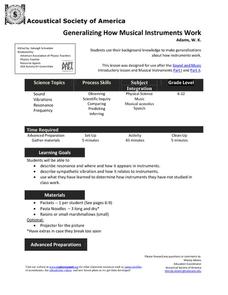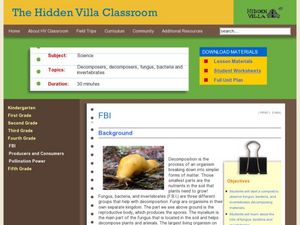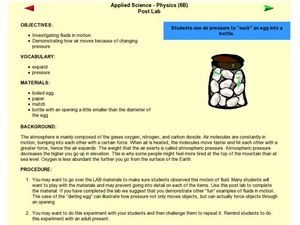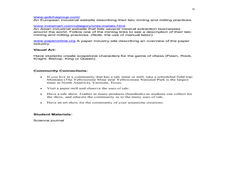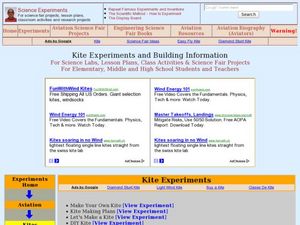Pyro Innovations
Beach Exploration
Little ones will absolutely love this lesson. It's all about the beach and what they can find while sifting through the sand. A large bucket of sand filled with hidden items is brought into the classroom. Learners will discuss what kinds...
Curated OER
Can Young Children Distinguish Between Living and Non-living Things?
What does it mean to be living? Help your young scientists identify living and non-living things as a result of their learning through discovery. Observation of and interaction with a set of natural phenomena in their community will make...
Acoustical Society of America
Generalizing How Musical Instruments Work
Sound, vibrations, resonance, and frequency are explored as learners use music to foster scientific inquiry. They engage in three different sound experiments and follow up discussions to foster a better understanding of how musical...
ARKive
Plants
Here is a one-hour activity that helps learners remember the parts of plants. Not only will the class learn about plant parts, they'll also discuss seed dispersal and plant growth. A celery experiment is used to show how plants obtain...
Nuffield Foundation
Working with Immobilized Enzymes or Microscopic Organisms
Let the lab be a catalyst to learn about enzymes. Scholars create alginate beads filled with yeast. As part of an investigation into enzymes, they see how these beads provide a catalyst to the reaction of glucose into ethanol.
Curated OER
SCHOOLYARD SUNDIAL
Students study the apparent motion of the Sun in the sky over the course of a day and a year, and analyze what causes seasons on Earth. They participate in a project that has both a science as well as an art component.
Curated OER
FBI
Fourth graders experiment with compost. In this Science activity, 4th graders begin a worm compost as well as an outdoor compost. Students discuss decomposition.
Hawaiʻi State Department of Education
Push and Pull
I love mixing arts lessons with core content! Here, the class will discuss energy, motion, and force (push/pull) as they review dance vocabulary and movements. They preview vocabulary for force and dance. Then they pair-up to dance a...
Curated OER
Your Five Senses
Students identify the five senses. In this biology lesson, students participate in an experiment and use their five senses to identify various substances.
Polar Trec
Foraging for Fish in a Melting Arctic
How much do you know about the black guillemot of the Arctic region? With great background information, images, and a quick discussion, the class will learn all about the plight of the foraging seabird as they play a fun game. First,...
Institute of Electrical and Electronics Engineers
Try Your Hand at Nano
Fascinating reading about nanotechnology, nanoscale properties, and liquid crystals precedes a fun activity for young engineers. They measure their hands in nanometers, research, and then investigate how heat effects a sheet containing...
Curated OER
"Eggs-perimenting" Fun
Students dissolve salt into water, place an egg into a glass of salt water, observe and record observations, make a scientific hypothesis, summarize what they studied from this hands-on experiment. They share their ideas and findings...
Curated OER
Applied Science - Physics Pos Lab (Air Pressure)
Students examine physics. In this air movement activity, students conduct an experiment that shows how air moves based on the pressure it's under. They watch the teacher complete the procedure and then try it on their own in a small...
Curated OER
Physical Science: Bubble Prints
Students participate in a lab experiment involving soap bubbles and making bubble prints. They blow bubbles into the soap and add paint to make bubble prints. With extra time, they can play with a variety of bubble toys to see what...
Curated OER
Bubble, Bubble, Soil and Fun!
Fifth graders experiment to find the physical properties and commercial uses of the mineral talc. They create a soapstone sculpture and a rubric for the creation.
Berkshire Museum
Adopt a Schoolyard Tree
Help young scientists connect with nature and learn about trees with a fun life science lesson. Heading out into the school yard, children choose a tree to adopt, taking measurements, writing descriptions, and drawing sketches of it in...
Curated OER
Tomato Exploration
Create tomatoes in 15-20 minutes using this fun and interactive lesson plan! Learners listen to a book about tomatoes (recommendations listed), and focus on the vocabulary word tomato. They count the syllables...
Baylor College
Food for Kids
Immediately capture the attention of your class with the smell of freshly popped popcorn in the sixth lesson of this series on the needs of living things. Young scientists first use their senses to make and record observations of...
Purdue University
Lifeguard Chair
Save the class from a lack of engineering experience. An engaging STEM activity has learners work in groups to design a lifeguard chair out of masking tape and index cards. They build and test prototypes, all while learning about the...
Curated OER
Fun With Adhesives
Students observe, measure, and record the properties in making objects stick together using science tools. In this science lesson, students explore with their senses while mixing flour and water. Additionally, students share their...
Captain Planet Foundation
Sense of Place
Explore the five senses with a kindergarten lesson on gardening. After taking a walk through the class garden, kids note what they see, hear, feel, taste, and smell, and then decide what is living in the garden versus what is not living....
Curated OER
Science Experiments with Eggs
ESL students experiment with eggs to learn the science concepts and science process language.
Curated OER
Kite Experiments and Building Information
Students build their own kite following certain procedures. In this physics instructional activity, students explain the aerodynamics concepts involved in flying kites. They trace the development of aviation.
Curated OER
Designing the Experiment and Answering the Question
Learners investigate scientific methods by analyzing an article from the Natural Inquirer. In this data analysis lesson, students read an article from the magazine and discuss at least 2 scientific methods that could be used to...


